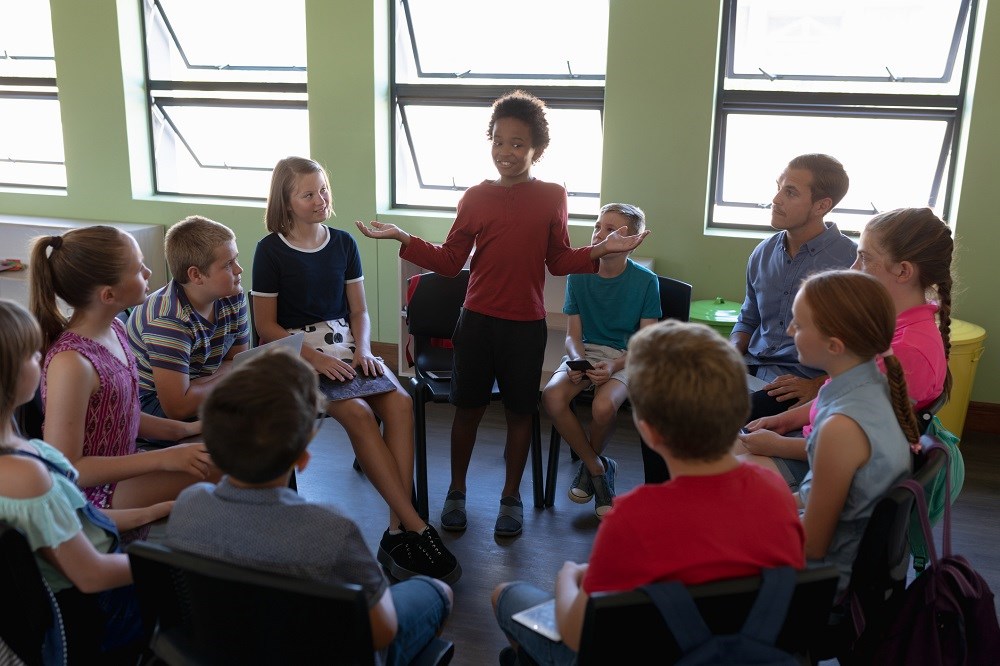Why Oracy Matters for Language Learners
Education programmes around the world promote literacy as a learning goal, but what about oracy? How can we encourage our learners to communicate, learn and express themselves through talking? In our latest MET blog post, David Dodgson explores what oracy actually is, why it is important for language learners and their progression in the classroom, and how it can be used in practice.
Oracy has been something of a buzzword around my place of work so far this term. After an excellent training session on ‘purposeful talk’ in a recent INSET session and a look at ‘Oracy in Action’ in a recent webinar I attended, I began to consider how this could help second language learners in both their language learning and wider study. This resulted in me encapsulating my initial thoughts of how oracy could work in my classes, weighing up what the benefits could be for my students’ learning, and considering what I needed to do to encourage them to want to develop their oracy … read on to find out what happened next.

What is oracy?
Before we go any further, this is perhaps a good place to start – what do we mean by ‘oracy in the classroom’? The basic dictionary definition reads ‘the ability to express oneself fluently in speech,’ but of course in the classroom, it goes deeper than that. Oracy focuses on the skill of academic talk – not just discussion and debate but the ability for learners to communicate ideas with each other in a manner referred to as ‘talking to learn’.
While literacy and numeracy are placed at the fore in general education settings, oracy is often forgotten. There is an assumption that talk will just happen. However, any educator who has wondered why tasks that require interaction between pairs or small groups sometimes fall flat will recognise that is not necessarily the case. Learners (not just language learners) need time, direction, and support in order to talk effectively and meaningfully.
How does it work in practice?
Oracy provides structure and purpose when we want our learners to share knowledge or ideas. They might, for example, be discussing a text they have just read. We can always supply them with questions to prompt their discussion as we usually do, but oracy adds some extra steps. Instead of giving them prompt questions, try supplying your learners with sentence starters to introduce points, such as:
- The main idea I got from the text is …
- I think the author is trying to tell us …
- I’m not sure what the author means by …
- I agree/disagree with the author’s point of view because …
Make sure you also give them time to think first, because this can provide a powerful frame for discussion with the ‘frontal load’ of forming an idea as a sentence taken away allowing the learners to focus on the content itself.

But beyond that, oracy also encourages a focus on turn taking. It can be worth also providing your learners with a second set of sentence starters to enable them to do this, for instance:
- That’s an interesting idea. You could also say …
- I’m not sure what you meant by … Can you explain?
- I think (by that) the author means …
- I’m not sure I agree because …
And my favourite:
- You’ve changed my mind about …
By assigning roles, for instance, giving students A and B each a different set of prompts, with B responding to A and visa versa, a meaningful discussion can occur that promotes sharing/exploring of ideas in a low stakes setting before a wider class discussion.
What happened in my classroom
I teach a group of ten teenage students (eight Chinese, one Japanese and one Russian) who are currently halfway through their IGCSE (International General Certificate in Secondary Education) ESL course. Last year, I asked them to review a sample answer to one of the written exam tasks they are preparing for. I explained what I wanted them to do, I checked they had understood my instructions, and asked them to explain the task back to me. Everything was set up right and then …
… but, then the talk died after about 20 seconds. They simply agreed the sample answer was ‘quite good’ and that was about it. It would have been easy to dismiss this as them being typical ‘quiet’ second language learners but I decided to make some changes.

A few weeks later when did a similar activity, I introduced guiding questions adapted from the ones I use for peer/self-assessment after a written task has been completed. The problem this time? They were all yes/no questions, for example, Has the author supported her point with an example? They went through the questions, said yes or no, and were done this time after 30 seconds.
After attending the oracy INSET, I decided to try again but this time with open questions (What is the author’s main point? How has she supported this?) I also included sentence starters to frame the discussion (all displayed on the board for reference). This time, a much livelier discussion ensued, lasting several minutes.
But more important than the discussion time was the outcome. The learners were able to not only say that the sample answer was ‘good’ but also why they thought that. Even better, they were able to say that despite it being a strong response, there was also room for improvement. And they suggested what those improvements might be!
This has helped their peer and self-correction as well – I now hear the same language being used when they give each other verbal feedback, such as I’m not sure what you mean by … Ah, ok – you’ve changed my mind! and so on.

There are, of course, a myriad of other oracy activities that we can use to encourage our learners to talk with more purpose, with more focus on learning and improving that I’ll come back to in my next post. For now though, why not leave us a comment below, or on Pavilion ELT’s or MET’s social media, to share some of the ways you bring oracy into the classroom?

Comments
Write a Comment
Comment Submitted